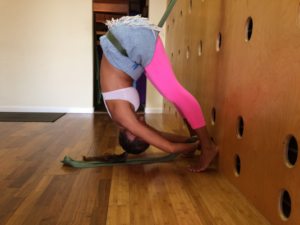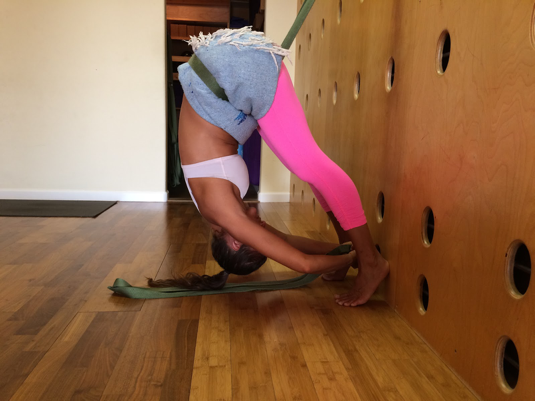A ROOT Awakening: Yoga Wall & Chill: The Ultimate “Hang Out”
Guest blogger: Elia Nikolaev, therapeuticvinyasayoga.com, @therapeuticvinyasa
A big thanks to Elia for sharing his expertise on the Yoga Wall System with the ROOT Tribe! Check out his bio below and learn about upcoming teacher trainings and future workshops through his website!
As a frequently intoxicated, insecure, and generally bewildered college student, yoga brought me relief from my existential anguish. I have grown tremendously through yoga and I can hardly imagine who or where I would be without the meaningful and authentic soul therapy of this practice.
Naturally, I decided to grow this passion and lifestyle through the path of becoming a yoga teacher. About one year into my teacher training journey, I became starkly aware of two mutually conflicting realities.
- How much students entrusted me with their well-being
- How little I knew about what can help them on their own journey
It was this moment that inspired me to expand my craft to the field yoga therapy. Yoga therapy challenged me to explore yoga on a deeper and more comprehensive level to support the full range of my students’ needs.
Shortly after, I stumbled upon BKS Iyengar’s yoga method, which is all about alignment. This method relies heavily on the standard props (blocks, belts, and bolsters), but there was one other prop that left me in awe. That prop was the Yoga Wall system.
The Yoga Wall (or as Iyengar called it “yoga kurunta,” which means “yoga puppetry”) was first designed by Mr. Iyengar to deepen his own personal practice (Click here for the full story). The ropes that harness you to the wall work by using gravity as a natural form of resistance to relieve the entire muscular-skeletal body of tension and pressure.

Most of us forget the effects gravity has on our body, especially over the span of a lifetime. In our modern world, we are confined to seated positions in our cars, at our jobs, in front of the TV, etc. Most people today are quite sedentary and, as a result, don’t get enough or proper movement in their lives. I’m not suggesting that sitting is the enemy, after all we all need rest to stay balanced. It is simply to point out the imbalances in posture and movement that our lifestyle imposes and how the yoga wall can be a marvelous remedy.
Safety: Tired of your joints feeling tired? When using the yoga wall, the body is securely harnessed to the wall which reduces the risk of injuries caused by some poses. The yoga wall also provides safer modifications for those of us with tighter bodies and limited range of motion, or lack of strength. Ever wanted to try a handstand, but were overcome with fear or simply didn’t think you had the physical strength? Well, with the yoga wall you can! You use the ropes to weightlessly hang and use the force of gravity to do all the work while you reap the benefits like spinal decompression, organ nourishment, and a quieter mind.
Therapeutic healing: Using the wall helps to unload our worn-out joints from their most common and harmful patterns of movement (think slouching a little too much or being a victim of “tech neck”). When you use the wall, you can distribute the weight-bearing elements of a certain pose in an un-habitual way. This is important to any level of student, whether one practices for specific therapeutic reasons like rehabbing from an injury or managing chronic pain symptoms, or to advance their current practice.
 Shifting our habits is essential for our growth and healing and the wall gives you the freedom to really switch up your movements and give your joints some relief.
Shifting our habits is essential for our growth and healing and the wall gives you the freedom to really switch up your movements and give your joints some relief.
Self-awareness: Self-awareness is an essential component to yoga therapy. This is where we learn not just about our bodies, but also have the space to explore our personalities, strengths, weaknesses, thoughts and emotions. Most of us (especially those of us who are new to the practice) tend to be so focused on the instructions being given and have little opportunity to explore how we feel in any given pose. The Yoga Wall has a unique ability to meet us where we are in our practice which afford us the opportunity to pay closer attention to the physical, mental, and emotional sensations that are present. When we have the space to explore ourselves in this way, we can slow down and observe what it is that is continuously ailing us. The more we know about ourselves, the more control we have over how we respond to life’s challenges.
What is critical to always keep in mind, is that the human body is a whole complex network that is dependent on outside forces such as gravity to perform its normal functions. It is both humbling and empowering to know how interdependent and interconnected the whole ecosystem of life is. In the same way that we rely on our muscles to help us move, the Yoga Wall and other props play a vital role in supporting and guiding our bodies and souls as we experience yoga and its healing benefits.
Want to learn more about the Yoga Wall? Check out Elia’s website therapeuticvinyasayoga.com
Are you a teacher in the field wanting to expand your skill set? Join Elia for a 3-day Yoga Wall Teacher Training! CLICK HERE for details.
 About Elia
About Elia
Elia Nikolaev is a Certified Yoga Therapist living in San Diego, CA. He specializes in skillfully adapting classical yoga poses to The Yoga Wall System and works with all skill levels. Elia completed his first training in 2006 and in 2013, Elia attended an extended live-study at the Iyengar Institute in Pune, India. Elia’s training includes mentorships with Richard Freeman, Usha Devi of Rishikesh, Josh Vincent, Carolyn Belko and Rachel Krentzman, PT, E-RYT. Elia is also a graduate of the Clinical Yoga Therapy program at Loyola Marymount University, where he participated in a clinical internship program led by Dr. Larry Payne, Ph.D and Lori Rubenstein- Fazzio, DPT, C-IAYT. To see all the creative ways Elia uses the yoga wall, follow him on Instagram: @therapeuticvinyasa


Recent Comments